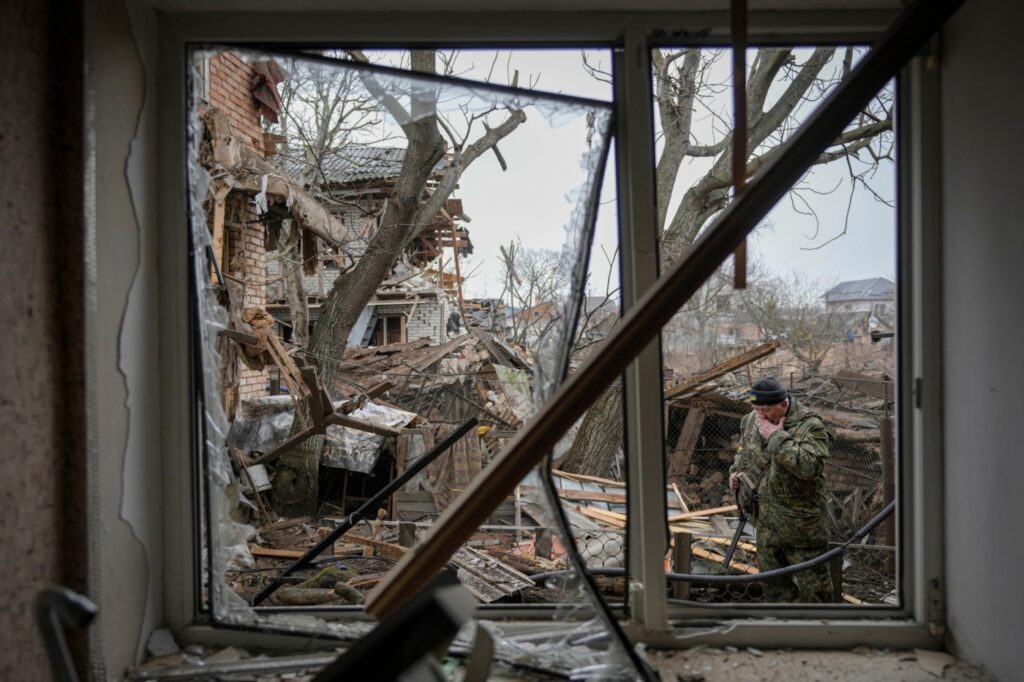
With the latest news from Ukraine, the war seems only to escalate. Civilian casualties are growing apace, as the Russian Army places more Ukrainian cities under siege. The prospect of hunger lurks behind the awful artillery barrages. Peace talks seem to be going nowhere. Meanwhile, the global economy could be teetering on the brink of massive recession as commodity prices are spiking. Could it get any worse? Yes, unfortunately, it could get a whole lot worse.
A foretaste of the next step in escalation was the 13 March Russian missile strike against the Ukrainian town of Yavoriv that killed 37. That town, just west of Lviv, is a mere 10 miles from the Polish border and lies along one of the main roads from Poland to Ukraine. The message from the Kremlin was threefold: it would not spare western Ukraine, it has plenty more firepower to bring to bear, and it would not tolerate NATO countries pouring volunteers and weaponry into Ukraine. These developments are disturbing enough on their own, but Western strategists also need to carefully consider one more aspect of the deadly strike against Yavoriv – the not-so-subtle hint that Putin might resort to the employment of tactical nuclear weapons.
On the same day as the Yavoriv strike, the New York Times ran a story on the front page about increased European demand for bomb shelter building over concerns of nuclear war. In general, this possibility has been glossed over, but the nuclear shadows in the background of the Russia-Ukraine War are already evident and they need to be better understood, including by the wider public.
Of course, it was not coincidental that Russia held nuclear weapons exercises in mid-Feb 2022 before the war. Then, Putin ordered these nuclear forces into “high combat readiness” on 27 Feb, just a few days after the beginning of the invasion. Acting responsibly, the Biden Administration chose not to counter-escalate by putting U.S. nuclear forces on alert. In another sign of restraint, the Pentagon cancelled a previously scheduled ICBM test. To be sure, these are positive signs, and evidence of stability at the strategic level. A large-scale exchange between Russian and U.S. arsenals remains improbable.
Unfortunately, a tactical nuclear exchange seems to be growing more possible with each passing day. Tactical nuclear weapons (TNW) or battlefield nuclear weapons were pervasive during the Cold War, but have not received much attention lately – until now. These weapons are not governed by any treaties, and the U.S. has decreased its arsenal over recent decades. Reversing that trend, however, a U.S. Navy submarine deployed to sea in early 2020 with a new low-yield weapon. Its new warhead, the W76-2, has an explosive yield, about ¼ that of the Hiroshima blast. Apparently, this weapon was brought into the force with Russia specifically in mind. Overall, the U.S. is thought to have a force of a few hundred TNW, most of which are old-style gravity bombs.
It is concerning, therefore, that Russia seems to deploy thousands of these weapons. Indeed, as recently as Jan 2022, a Russian military newspaper noted: “Russia is many times superior to the United States in terms of tactical nuclear weapons. According to expert estimates, there are about 1,900 tactical warheads in Russia.” In Russia’s extensive TNW arsenal, one of the most dangerous weapons is the Iskander short-range missile, that is described as “designed to evade missile defenses.” Moreover, almost all Russian warships and submarines carry the Kalibr long-range cruise missile that is also capable of carrying a nuclear warhead.
What targets would Russia choose if it came to the use of TNW? Most likely the Kremlin would opt for military targets in Ukraine. But it cannot be discounted that Moscow may target NATO staging areas in Poland, Romania or Germany where arms are flowing to Ukraine from. Of course, the Kremlin would anticipate U.S. retaliation, but the concept would be to “escalate to de-escalate.” In other words, the idea is to employ nuclear weapons in a limited way to shock the other side into stopping the war.
Related Articles
Mayor may not see much foreign service
Lasting COVID legacy: a nation of rulers, not laws
What’s at stake in the Russia-Ukraine war
Todd Spitzer’s hypocritical smearing of Pete Hardin
Republicans act on homelessness where Democrats have failed
Under what circumstances would Putin opt for such a tragic and perilous plan? Here it is particularly instructive to read an unclassified report from the Naval War College on “nuclear use” written in 2021: “Moscow is unlikely to use nuclear weapons … unless the Putin regime judged that an impending defeat during conflict would undercut the government’s legitimacy and create an existential threat via domestic upheaval (through loss of territorial integrity or other pivotal wartime event).”
We are at an exceedingly dangerous moment in world history. Those who have studied the Cuban Missile Crisis carefully know that the most dangerous parts of the crisis involved the possible use of TNW, which almost occurred more than once. The Biden Administration has been wholly correct to avoid such circumstances, and has generally abjured any moves to counter-escalate. There cannot be a NATO-enforced no-fly zone over Ukraine without risking WWIII and NATO should be exceedingly cautious regarding the flow of weapons and volunteers into the warzone, as such steps could quite easily spiral into truly apocalyptic outcomes.
Lyle Goldstein is the Director of Asia Engagement at Defense Priorities and a Visiting Professor at the Watson Institute of Brown University.
